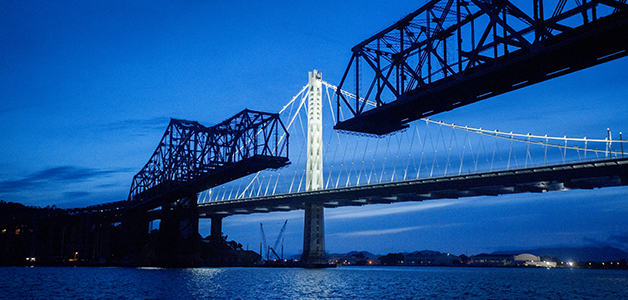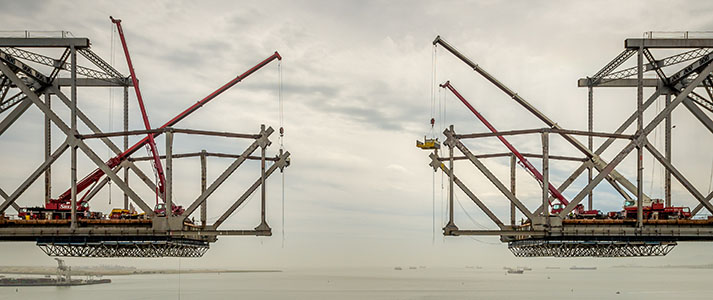Last September’s historic opening of the new Bay Bridge East Span truly was a landmark event, not only marking the culmination of a decades-long effort to deliver seismic safety on the Bay Area’s state-owned bridges, but also setting the scene for a historic disappearing act.

Piece by piece, the old East Span of the Bay Bridge is demolished, revealing a stunning twilight view of its replacement. Photo by Noah Berger
By John Goodwin
Published: July, 2014
Last September’s historic opening of the new Bay Bridge East Span truly was a landmark event, not only marking the culmination of a decades-long effort to deliver seismic safety on the Bay Area’s state-owned bridges, but also setting the scene for a historic disappearing act.
Work crews earlier this year began the first phase of a three-part process to dismantle the two-mile-long original East Span. The middle portion of the old bridge’s cantilever section over the deep water east of Yerba Buena Island has already given way to a 600-foot void that is clearly visible to motorists traversing the adjacent new span.
Project schedules call for the old gray span to be gone completely by the end of 2016, when its brilliant white replacement will stand alone as the newest jewel in the world-renowned collection of architectural and engineering gems adorning San Francisco Bay.
Demolition of the old East Span is taking place roughly in the reverse order of how the structure was built from 1933 to 1936. By the time the operation is completed, over 58,000 tons of steel and 245,000 tons of concrete will have been removed.
Phase 1 — performed by a joint venture between Oakland-based Silverado Contractors Inc. and Pleasanton-based California Engineering Contractors (CEC) — began with the careful dismantling of the 1,400-foot cantilever section, the tallest portion of the old bridge. Long before workers sliced through the middle of this section and separated the two halves of the cantilever, they made painstaking preparations to reduce structural tension, pulling the end of each section toward the rest of the bridge to ensure the halves wouldn’t collapse and tip into the water below.
Phase 2 of the demolition project will involve removal of the old bridge’s truss section, which stretches from the east end of the cantilever to the Oakland shoreline. Caltrans expects to advertise the contract for this work by the end of July. Because the removal of one piece of a truss bridge can change the balance of loads throughout the rest of the structure and create a spring-action effect, Caltrans engineers are using a 3-D computer-modeling program to monitor how the forces are distributed.
As the demolition moves to Phase 3, contractors will venture beneath the bay waters to remove the 22 piers and associated foundations that supported the original span, possibly using implosive charges to speed the work.
View demolition webcams at bata.mtc.ca.gov, or get a front row view by walking or biking the path along the new East Span. See map at baybridgeinfo.org.

In Phase 1 of the demolition of the old East Span of the Bay Bridge required painstaking preparations to reduce structural tension to ensure the halves wouldn’t collapse and tip into the water below when the bridge was actually cut into two sections. By the time the operation is completed, over 58,000 tons of steel and 245,000 tons of concrete will have been removed. Left Photo by Sam Burbank, Middle Photo by Noah Berger, Right Photo by Sam Burbank

Demolition of the old East Span is taking place roughly in the reverse order of how the structure was built from 1933 to 1936, providing viewers with a unique window into the past. Photo by Sam Burbank

